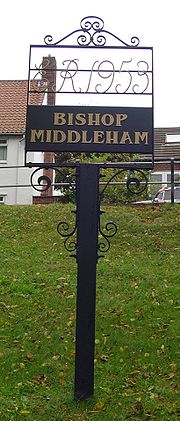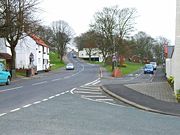
Bishop Middleham
Encyclopedia

County Durham
County Durham is a ceremonial county and unitary district in north east England. The county town is Durham. The largest settlement in the ceremonial county is the town of Darlington...
, in England
England
England is a country that is part of the United Kingdom. It shares land borders with Scotland to the north and Wales to the west; the Irish Sea is to the north west, the Celtic Sea to the south west, with the North Sea to the east and the English Channel to the south separating it from continental...
. It is close to Sedgefield
Sedgefield
Sedgefield is a small town and civil parish in County Durham, England. It has a population of 4,534.Sedgefield has attracted particular attention as the Member of Parliament for the wider Sedgefield constituency was the former Prime Minister Tony Blair; he was the area's MP from 1983 to 2008,...
.

History
Bishop Middleham lies in a valley about 9 miles south-west of DurhamDurham
Durham is a city in north east England. It is within the County Durham local government district, and is the county town of the larger ceremonial county...
. Although much of County Durham
County Durham
County Durham is a ceremonial county and unitary district in north east England. The county town is Durham. The largest settlement in the ceremonial county is the town of Darlington...
had probably first been settled in the Mesolithic period, the first evidence for occupation in the parish dates to the Neolithic
Neolithic
The Neolithic Age, Era, or Period, or New Stone Age, was a period in the development of human technology, beginning about 9500 BC in some parts of the Middle East, and later in other parts of the world. It is traditionally considered as the last part of the Stone Age...
or Bronze Age
Bronze Age
The Bronze Age is a period characterized by the use of copper and its alloy bronze as the chief hard materials in the manufacture of some implements and weapons. Chronologically, it stands between the Stone Age and Iron Age...
. At least two simple flint tools, including an arrowhead, have been found in the area. The arrowhead was probably used by an early hunter, though by the Bronze Age farming would have been widespread. By the Iron Age
Iron Age
The Iron Age is the archaeological period generally occurring after the Bronze Age, marked by the prevalent use of iron. The early period of the age is characterized by the widespread use of iron or steel. The adoption of such material coincided with other changes in society, including differing...
we have our first evidence for burials in the parish- at least six graves were found in a small cave. A small glass bead decorated with white spiral patterns may also have come from an early or middle Iron Age grave, though it may have been lost in another way.
It is clear that Bishop Middleham was on an important Roman period routeway; the road known as Cades Road runs through the centre of the parish. Despite the presence of this important communication route, no Roman buildings have been found in the parish. Nonetheless several other Roman objects have been uncovered in the area, including a small bronze statue of a Roman god. More unusually a group of four Roman pans stacked one inside each other have also been discovered. They were decorated so as to give them a silver appearance. It is possible they may have had a religious use, as such pans are often shown carved on the site of Roman altars. The discovery of these objects and the small statue may suggest that an as yet undiscovered Roman temple is still to be found.
There is little hard evidence for Anglo-Saxon settlement in the parish, though as Middleham is an Old English name for 'middle settlement or farm' there was certainly some kind of occupation in the area by the 9th or 10th centuries.
In 1146 Osbert, the nephew of Bishop Flambard
Ranulf Flambard
Ranulf Flambard was a medieval Norman Bishop of Durham and an influential government minister of King William Rufus of England...
, gave the Church of Middleham to the Prior and Convent at Durham, this is the first recorded mention of the village. In 1183 the Boldon Book
Boldon Book
The Boldon Book contains the results of a survey of the bishopric of Durham that was completed on the orders of Hugh du Puiset, Bishop of Durham, in 1183, designed to assist the administration of the vast diocesan estates...
, a survey of all the land owned by the Bishop of Durham, records that there were some 32 households in the village, which was surveyed along with neighbouring Cornforth. The survey was particularly detailed and names a number of individuals such as Arkil, Ralph and William the Headborough. Bishop Middleham was one of the favourite residences of the Bishops of Durham, two of whom died here. The residence of the Bishops now only survives as earthwork remains.
By the late 14th century the Bishop of Durham appears to have no longer used the Castle as a residence and the buildings and land were let out at first to his bailiff. By 1509 this was a man named John Hall who enjoyed a lease of 31 years. The castle and deer park passed through a number of hands over the following centuries including the Eure family of Witton Castle
Witton Castle
Witton Castle is a much altered 15th century castle, which is the centrepiece of a holiday and caravan country park at Witton le Wear, near Bishop Auckland, County Durham. It is a Grade II* listed building.-Details:...
, the Freville's and by the 18th century the Surtees family which included the notable historian Robert Surtees
Robert Surtees (antiquarian)
Robert Surtees was a celebrated English historian and antiquary of his native County Durham. Surtees was born in Durham, and educated at Kepier School, Houghton-le-Spring, and later at Christ Church, Oxford. Although a student of law he never practised as a lawyer...
, who lived nearby at Mainsforth and wrote on the village and Castle in his History of Durham in 1823. He is buried in Bishop Middleham church.
By the 19th century the contained four public houses, a brewery, and a few tradesmen's shops. The village mainly supported itself by farming, though there was some coalmining; the remains of a wagonway have been recorded. The main railway line also ran close to the village.
St Michael's Church
"The Church, dedicated to St. Michael, stands upon the hill south of the village, and is said to have been erected by Bishop Beck, but it is more probably the work of Bishop Poor, and of the date about 1230. It was in 1146 presented to the prior and convent of Durham by Osbert, nephew of Bishop Flambard, but it was soon afterwards annexed to the Priory of Finchale, by Bishop Robert de Insula, and so continued till the dissolution. It is a venerable structure, in the Early English style, and consists of nave, chancel, and aisles, with a western bell turret."Football club
Bishop Middleham Football Club are an up and coming English football side that play in the Durham County Sunday Football League. They are currently managed by Hugh Coulthard and are on course to achieve back to back promotions since joining the league in 2006.Environment
The Bishop Middleham Community Wildlife Garden (0.87 hectares) has been declared a designated Local Nature ReserveLocal Nature Reserve
Local nature reserve or LNR is a designation for nature reserves in the United Kingdom. The designation has its origin in the recommendations of the Wild Life Conservation Special Committee which established the framework for nature conservation in the United Kingdom and suggested a national suite...
by Sedgefield council.
Notable residents
- Samuel Taylor ColeridgeSamuel Taylor ColeridgeSamuel Taylor Coleridge was an English poet, Romantic, literary critic and philosopher who, with his friend William Wordsworth, was a founder of the Romantic Movement in England and a member of the Lake Poets. He is probably best known for his poems The Rime of the Ancient Mariner and Kubla...
, the celebrated poet stayed in Bishop Middleham with Sara Hutchinson and her brother George in 1801. - Thomas HutchinsonThomas Hutchinson (scholar)Thomas Hutchinson was an English clergyman and classical scholar.-Life:The son of Peter Hutchinson of Cornforth, in the parish of Bishop Middleham, County Durham , was baptised there on 17 May 1698. He matriculated at Lincoln College, Oxford, on 28 March 1715, and graduated B.A. 1718, M.A. 1721,...
a scholar, was born here in 1698 - Sir Henry TaylorHenry Taylor (dramatist)Sir Henry Taylor was an English dramatist.Taylor was born in Bishop Middleham, the son of a gentleman farmer, and spent his youth in Witton-le-Wear with his stepmother at Witton Hall in the high street...
, Author, and friend of Wordsworth was born in Bishop Middleham
External links
- Bishop Middleham Online community website

